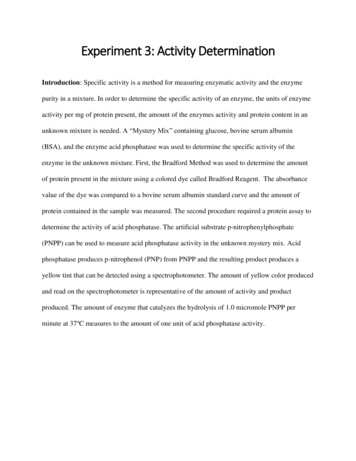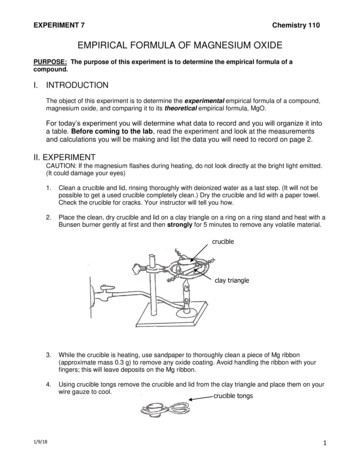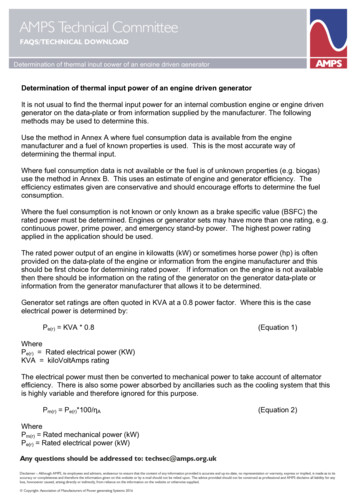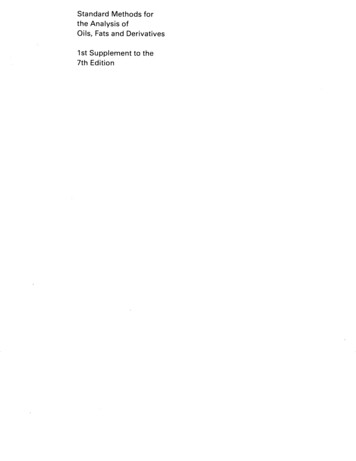
Transcription
Experiment 3: Activity DeterminationIntroduction: Specific activity is a method for measuring enzymatic activity and the enzymepurity in a mixture. In order to determine the specific activity of an enzyme, the units of enzymeactivity per mg of protein present, the amount of the enzymes activity and protein content in anunknown mixture is needed. A “Mystery Mix” containing glucose, bovine serum albumin(BSA), and the enzyme acid phosphatase was used to determine the specific activity of theenzyme in the unknown mixture. First, the Bradford Method was used to determine the amountof protein present in the mixture using a colored dye called Bradford Reagent. The absorbancevalue of the dye was compared to a bovine serum albumin standard curve and the amount ofprotein contained in the sample was measured. The second procedure required a protein assay todetermine the activity of acid phosphatase. The artificial substrate p-nitrophenylphosphate(PNPP) can be used to measure acid phosphatase activity in the unknown mystery mix. Acidphosphatase produces p-nitrophenol (PNP) from PNPP and the resulting product produces ayellow tint that can be detected using a spectrophotometer. The amount of yellow color producedand read on the spectrophotometer is representative of the amount of activity and productproduced. The amount of enzyme that catalyzes the hydrolysis of 1.0 micromole PNPP perminute at 37oC measures to the amount of one unit of acid phosphatase activity.
Results: The table below includes data pertaining to the standard curve solutions created and themystery mix solutions obtained along with their absorbance readings. Attached are the printoutsfrom the Genesys 5 Spectrophotometer date including the plotted standard curve relative to theamount of BSA and the amount of Mystery Mix protein that reacted with the Bradford colorreagent.Procedure 1- Protein ContentFigure 1.TubeBovineSerumAlbumin ( g)25 l/mlBSA (ml)0.15 MNaCl(ml)BradfordReagent(ml)A595nmTube20 FoldMystery Mix(ml)0.15 -0.90.80.60.40-0.0830.1420.2400.3150.419-Standard CurveConcentration ( g)Mystery MixAbsorbanceConcentration ( g)AbsorbanceTube11.00.053Tube 71.73860.083Tube 25.000.190Tube 83.72570.142Tube 310.000.306Tube 97.32700.240Tube 415.000.402Tube 1010.4200.315Tube 520.000.495Tube 1115.4560.419Tube 625.000.556The amount of protein present in the five unknown tubes was calculated from g to mg/tube.Tube 7 (0.1 ml Mystery Mix): 1.7386/1000 1.174 x 10-3 mg/tube (0.00174Tube 8 (0.2 ml Mystery Mix): 3.7257/1000 3.726 x 10-3 mg/tubeTube 9 (0.4 ml Mystery Mix): 7.3270/1000 7.327 x 10-3 mg/tubeTube 10 (0.6 ml Mystery Mix): 10.420/1000 1.042 x 10-2 mg/tubeTube 11 (1.0 ml Mystery Mix): 15.456/1000 1.546 x 10-2 mg/tube
Total amount of protein in the mystery mix umber 38 was calculated from the values given from theGenesys 5 and the average was determined.Mg protein in tube * DFSample Volume (ml) in tube * Total volume of “stock” protein solution mg total proteinin stock solutionTube 7:1.174 x 10-3 mg/tube0.1 mlx20Tube 8:3.726 x 10-3 mg/tube0.2 mlx20Tube 9:7.327 x 10-3 mg/tube0.4 mlx20Tube 10:1.042 x 10-2 mg/tube0.6 mlx20x 6 ml 2.084 mgTube 10:1.546 x 10-2 mg/tube1.0 mlx20x6 ml 1.855 mgx 6 ml 1.408 mgx 6 ml 2.236 mgx 6ml 2.198 mgAverage : 1.956 mg total proteinProcedure 2- Enzyme ActivityThe acid phosphatase activity assay was then performed using amounts of the mystery mix solution ranging from0.1 ml to 0.8 ml. Other solutions of 0.5 ml 1.0M sodium acetate buffer, 0.5ml 0.05M p-nitrophenyl phosphate, andvarying amounts of water to make the total volume of 5.0 ml were added to the tube. A tube containing all thesolutions except the enzyme was also created to serve as the blank. The solutions with the varying Mystery Mixamounts were duplicated into samples A and B and incubated in 37 OC water bath and KOH was added to stop theassay reaction. After ending the reaction, the solutions and their absorbances were recorded in the table below.Figure 05 MPNPP(ml)0.50.50.50.50.5dH2O(ml)MysteryMix (ml)3.93.83.63.240.10.20.40.8-0.5 090.6521.123-
The calculations below were used to convert to moles/min. A simplified equation was determined toobtain the same values.Example Equations (including sample absorbance value of 1.123)A clc /c 1.123/18800 5.973 x 10-5 molarityMolarity# of minutes for assay reaction 5.973 x 10-5 5 min1.1946 x 10-5 moles/litterminmoles/litter x number of liters (1.1946 x 10-5 ) x (0.0075 liters) 8.960 x 10-8 Unitsminin reaction assaymoles/ minx1x106 moles/1mole (8.960 x 10-8) x (1x106) 8.960 x 10-2 UnitsSimplified equations (including all average absorbance values)(1.123)(0.0798) 8 .96 x 10-2 moles/min Units(0.652)(0.0798) 5.20 x 10-2 moles/min Units(0.3095)(0.0798) 2.47 x 10-2 moles/min Units(0.172)(0.0798) 1.37 x 10-2 moles/min Units
The level of activity attributed to the amount of protein containing solution used to initiate the reactionwas calculated.Units# ml of protein solution added to assay 8.96 x 10-2 0.112 Units/ml0.8 mlUnits# ml of protein solution added to assay 5.20 x 10-2 0.13 Units/ml0.4 mlUnits# ml of protein solution added to assay 2.47 x 10-2 0.12 Units/ml0.2 mlUnits# ml of protein solution added to assay 1.37 x 10-2 0.137 Units/ml0.1 mlThe Total Units of Enzyme Activity was calculated by multiplying the Units/ml obtained by the dilutionfactor of 1.Units x DF x ml of stock protein solution Unitsml0.112 units/ml x 1 x 6ml 0.67 Units of Enzyme Activity0.13 units/ml x 1 x 6ml 0.78 Units of Enzyme Activity0.12 units/ml x 1 x 6ml 0.72 Units of Enzyme Activity0.137 units/ml x 1 x 6ml 0.82 Units of Enzyme Activity
Finally, the specific activity amount was calculated using the Total units of enzyme activity calculated inprocedure 2 divided by the average total protein calculated in procedure 1.Total Units of Enzyme ActivityTotal Protein0.672 0.344 Units/mg1.9560.78 0.400 Units/mg1.9560.72 0.368 Units/mg1.9560.82 0.419 Units/mg1.956Average 0.383 Units/mgDiscussion: Specific Activity was used to determine the units of enzyme activity per mg of proteinpresent in the mystery mix solution that contained unknown amounts of glucose, bovine serum albumin,and acid phosphatase. Specific activity is used to represent the amount of substrate a given enzymeconverts per mg of protein in the solution through a given amount of time. Because the solution containsunknown amounts of its contents, the protein content and enzyme activity were necessary before thespecific activity of the enzyme could be determined. Enzymologists determine specific activity in orderto determine the purity of the enzyme sample mixture. As the enzyme becomes more pure in a mixture,the specific activity value increases. Purified proteins are valuable for production of growth factors,hormones, DNA polymerases, and antibodies that are useful in the medical technology and research fieldswhere they can create life-saving products and make a profit. The specific activity of acid phosphatasewas calculated at 0.383 Units/mg protein. The expected range of the specific activity is known to be 0.052.0 units/mg of protein. The calculated value therefore falls within the expected range of the specificactivity for the enzyme acid phosphatase.
A “Mystery Mix” containing glucose, bovine serum albumin (BSA), and the enzyme acid phosphatase was used to determine the specific activity of the enzyme in the unknown mixture. Fi










